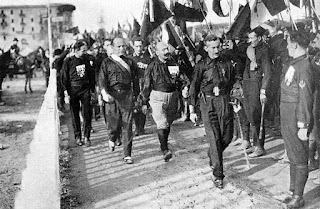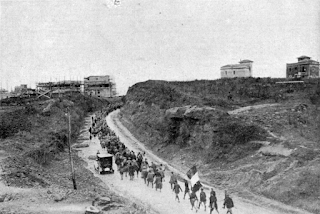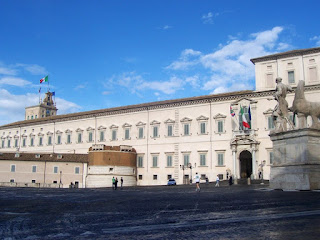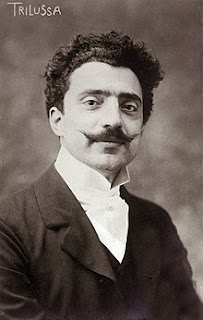The insurrection that put Fascists in power
 |
| Mussolini (second left) walked alongside Cesare Maria de Vecchi during part of the March on Rome |
A mob comprising thousands of members of Mussolini’s Blackshirt militia and other party supporters converged on the city, intent on seizing power. At the same time, other Blackshirt groups were capturing strategic locations throughout Italy.
Italy’s Liberal prime minister, Luigi Facta, wanted to deploy the army to put down the insurrection and hastened to the Palazzo del Quirinale to see the king, Victor Emmanuel III, and ask him to sign a decree of martial law so that he could put Rome in a state of siege.
At first, the monarch was prepared to grant his request, but after giving it more thought he changed his mind, much to Facta’s consternation.
Instead, the Blackshirt mob, headed by four Mussolini henchmen - Italo Balbo, Cesare Maria De Vecchi, Michele Bianchi and Emilio De Bono - were allowed to enter Rome unchallenged. By the following day, what had been effectively a bloodless coup d’état was completed when Victor Emmanuel III invited Mussolini to form a government and at the age of 39 become what was then Italy’s youngest prime minister.
 |
| Victor Emmanuel III handed power to Mussolini |
In fact, he had probably over-estimated the strength of Mussolini’s insurgents, who numbered nowhere near the 50,000 that the Fascist hierarchy had hoped to assemble, possibly as few as 10,000, many of whom were rural workers armed with little more than pitchforks.
A slightly more noble explanation is that Victor Emmanuel feared that Italy was on the verge of civil war and saw handing power to Mussolini as an expedient way to avert it.
Certainly, over the preceding two or three years, there had been considerable discontent over wages and prices among Italian workers, with waves of strikes taking place. The Italian Socialist Party had made gains in local elections and in 1919 - the year that Mussolini formed his Fasci Italiani di Combattimento, which would evolve into the National Fascist Party - had their most successful result in a general election, winning 156 seats in the Chamber of Deputies.
Dissatisfied with the reluctance of the Rome government to act against the workers, many landowners and business bosses increasingly turned to Mussolini’s fledgling Blackshirt militias to quell industrial action, supported by establishment figures worried by the rise of the socialists.
In August 1922, the Fascists took it upon themselves to suppress a general strike, claiming they were the party of law and order as opposed to an ineffectual official government. They did so by violent means, torching buildings they believed to be used by socialists.
 |
| Members of Mussolini's Blackshirt militia en route to Rome in 1922 |
All the time, the government in Rome sat back and watched, which emboldened Mussolini, by now supported and sponsored by business owners and most on the political right, to make his grab for absolute power.
Within a little over two years of the king’s capitulation, Mussolini had turned his premiership into a dictatorship, after which Italy had to endure two decades of brutality and suppression that ended only when the occupying forces of Nazi Germany had been defeated by the Allies.
After the war, Victor Emmanuel III was sent into exile along with all members of the Italian Royal Family, his siding with Mussolini never forgiven as Italians voted to become a republic.
Yet 100 years after his rise to power, the self-proclaimed Duce still has sympathisers in the country and reminders of his regime are not difficult to find in many parts of Italy, such as the obelisk inscribed with the words Mussolini Dux that still stands near the Stadio Olimpico in Rome.
The giant fashion house Fendi has its headquarters in the Palazzo della Civiltà Italiana, an imposing six-story marble structure in the Mussolini-built EUR district of the capital, on which is engraved a phrase from a speech made by the dictator announcing his invasion of Ethiopia in 1935.
Indeed, with somewhat chilling timing, the anniversary of Mussolini’s ascent to power has coincided with the installing as prime minister of Giorgia Meloni, leader of the far-right Brothers of Italy party, herself a former member of both the Italian Social Movement, founded in 1946 by Mussolini supporters, and the post-fascist National Alliance.
 |
| The Palazzo del Quirinale has been the official residence of popes, kings and presidents |
The Palazzo del Quirinale, which until 1946 was the official residence of Italy’s reigning monarch, was built in 1583 by Pope Gregory XIII as a summer residence. It also served as the offices of the civil government of the Papal States until 1870. When, in 1871, Rome became the capital of the new Kingdom of Italy, the palace became the official residence of the kings of Italy, although some monarchs, notably Victor Emmanuel III (1900–1946), lived in a private residence elsewhere. When the monarchy was abolished in 1946, the Palazzo del Quirinale became the official residence and workplace for the presidents of the Italian Republic. So far, it has housed 30 popes, four kings and 12 presidents.
_(5904657870).jpg) |
| The Palazzo della Civiltà Italiana is one of the most striking buildings in Rome's EUR district |
The EUR complex, to the south of the centre of Rome, was originally developed to host the 1942 World's Fair - the Esposizione Universale Roma - which was cancelled because of the Second World War. Mussolini’s modern city within a city was designed by a team of prominent architects, headed by Marcello Piacentini and including Giovanni Michelucci. The designs combined classical Roman elements with Italian Rationalism in a simplified neoclassicism that came to be known as Fascist architecture. The Palazzo della Civiltà Italiana, which has become known as the “square colosseum”, is regarded as the building which is the most symbolic of EUR. Designed by Giovanni Guerrini, Ernesto La Padula, and Mario Romano, it draws inspiration from the Colosseum with its rows of arches, while its square shape and stark whiteness are reminiscent of metaphysical art.
Also on this day:
312: The Battle of the Ponte Milvio
1639: The death of composer Stefano Landi
1963: The birth of singer-songwriter Eros Ramazzotti
1973: The death of comic actor and illustrator Sergio Tòfano
.jpg)
.jpg)
.jpg)

.jpg)
.jpg)


.jpg)




